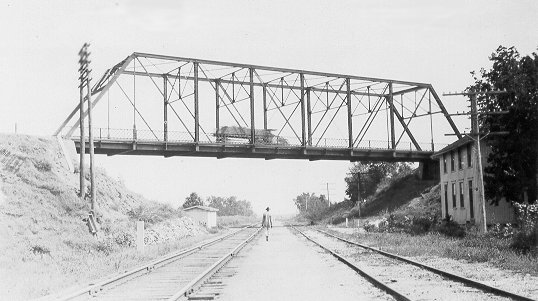|
PRATT THROUGH TRUSS
1901 Ottawa 58E0062N4510004 Midland Br.
1908 Logan 42N3270E0830002 Canton Br.
1908 Logan 42N3150E0670003 Canton Br.
1909 Washington 74E0320N4020001 Missouri Valley Br.
1909 Washington 74E0340N3990006 Missouri Valley Br.
1911 Comanche 16N2430E1720002 Stupp Bros. Br.
1912 Logan 42E0640N3050007 Canton Br.
1913 Cotton 17E1961N2640002 Kansas City Br.
1913 Washington 74N3936E0200009 Rochester Br.
1914 Bryan 07E2135N3900007 Missouri Valley Br.
1914 Osage 57-No Number Rochester Br.
1916 Payne 60E0660N3390002 Boardman Co.
1916 Pushmataha 64N4485E1620007
1919 Choctaw 12E2017N4035004 Kansas City Br.
1938 LeFlore 40E1550N8400000
The no-nonsense functionalism of the truss, amply illustrated by the pony span, becomes something more in the through truss bridge. Here, its scale enlarged, the truss becomes an object of greater strength and grace, even attaining a degree of majesty in the way it commands a place over a waterway. Stately and dignified, the through truss makes one appreciate the genius of engineered design and the consummate skill of industrial builders. Oklahoma has a fine representation of this historical and technological resource, through trusses amounting to approximately 20% of the state's total stock of truss bridges.
The most numerous through truss in the state utilizes the Pratt configuration, with spans generally built before 1920 connected by pins, later ones having rigid connections. The upper chord, end posts, and central verticals in this design resist compressive forces, meaning that they are heavier weight members and generally made from channel riveted with lace. Tension members, which include the lower chord, hip verticals, diagonals, and counters, must be lighter and more flexible to accomplish their purpose in the span. Round or square eyebar became the choice for bottom chords and hip verticals in pinned bridges. Counters, which function in supporting a live load on the bridge, consisted of eyebars fitted with turnbuckles so that the span could be tightened in the field.
The oldest Pratt crosses the Neosho River west of Commerce, a location to which it was moved during the 1920s. When constructed in 1901, this two span bridge--each apan 180 feet long, making them the longest of their type in the state--crossed the same river on Main Street in Miami at a traditional ford and ferryboat location (Figure 59). Further qualifying it as a significant bridge, it was the first great project of the Midland Bridge Company, which went on to become a prolific builder in Oklahoma until 1920. The Canton Bridge Company, the state's leading builder based on historical records, produced many Pratts that bolstered its reputation as the maker of reliable and efficient spans. Apropos of this, in 1908 it built a 102-foot Pratt across Bear Creek for Logan County that improved transportation for the Meridian community. Through a conventional structure, it brought modern times to the area and was seen as a sign of progress by those who came to depend upon it.
For differing reasons, two Pratts merit particular attention. A 100-foot span near Chattanooga in Comanche County provides the only example of a bridge by the Stupp Brothers Bridge and Iron Company. This St. Louis company generally specialized in large trusses, primarily for the railroads, and thus produced relatively few highway spans. The Stupp Brothers' company is still active in bridge construction. Not more than thirty miles away in Cotton County stands the earliest riveted Pratt through truss, built in 1913 by Kansas City Bridge Company (Figure 60). Fewer of this type remain because as rigid connections came into use the Pratt through truss had nearly reached the end of its building cycle.
|



